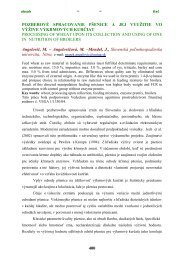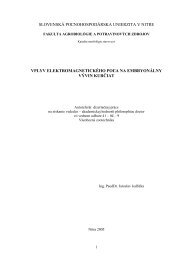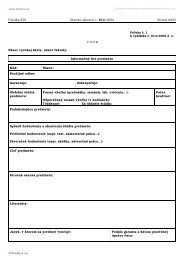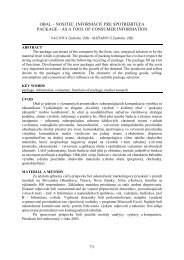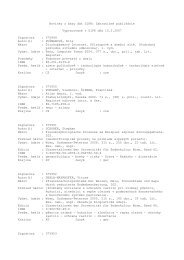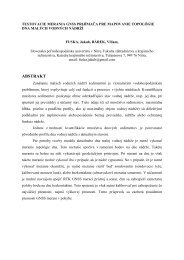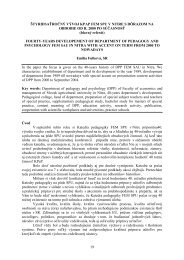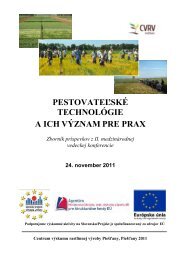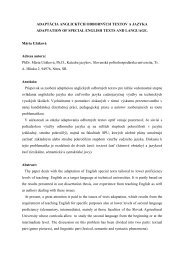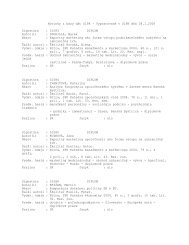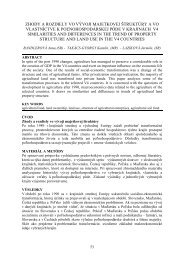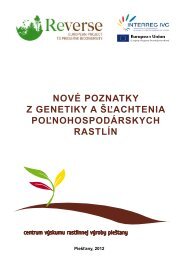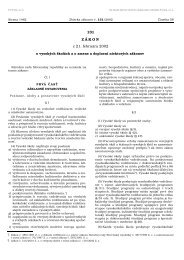Acta fytotechnica et zootechnica, Vol. 4, 2001, Special Number ...
Acta fytotechnica et zootechnica, Vol. 4, 2001, Special Number ...
Acta fytotechnica et zootechnica, Vol. 4, 2001, Special Number ...
You also want an ePaper? Increase the reach of your titles
YUMPU automatically turns print PDFs into web optimized ePapers that Google loves.
<strong>Acta</strong> <strong>fytotechnica</strong> <strong>et</strong> <strong>zootechnica</strong>, <strong>Vol</strong>. 4, <strong>2001</strong>, <strong>Special</strong> <strong>Number</strong><br />
Proceedings of the International Scientific Conference on the Occasion of the 55 th Anniversary of the Slovak Agricultural<br />
University in Nitra<br />
Summary<br />
THE SPECIFICS OF THE WATER REGIME OF THE SOILS ON THE EAST-SLOVAKIAN LOWLAND<br />
Rastislav MATI<br />
Research Institute of Agroecology, Michalovce, Slovak Republic<br />
The specificity of the soil relations on the East-Slovakian Lowland reside in the predominance of the soils with the glei<br />
soil-forming processes which include up to 65% of the agricultural soil.<br />
The results of the dynamics of the supply of soil humidity and its influence on the yields of the field crops hint at the<br />
limiting effect of the high supply of the soil humidity at the beginning of the veg<strong>et</strong>ation period as well as at the limiting effect<br />
of its deficiency in the second half of the veg<strong>et</strong>ation period on the same soil stand.<br />
The respect of the specifics of the economy with the soil humidity require the increase of the function efficiency of the<br />
built hydromelioration plants, the restructuring of exploitation of agricultural soil, the restructuring of the plant production<br />
and the differentiated agricultural procedure in the case of respect of the soil conditions.<br />
Key words: soil conditions of the East-Slovakian Lowland, the supply of soil water, the economy with the soil humidity<br />
Introduction<br />
The characteristic phenomenon of the East-Slovakian Lowland is the representation of soil types. The older works<br />
mention relatively high representation of Eutric fluvisol (up to 29%) as well as Albic luvisol (9%). However, the latest data<br />
from the soil evaluation (VILČEK, 1998) demonstrate that the acreage of the typical Eutric fluvisols is only about 7%. The<br />
predominance of the soils with the glei soil-forming processes (Fluvi-eutric gleysols, Fluvi-mollic gleysols, Gleic<br />
planosols, Eutric gleysols). The mentioned soil representatives cover up to 65% acreage of the agricultural soil of territory.<br />
The dynamics of the soil water as a result of the activity of natural factors, which has in time and space characteristic<br />
course, is termed a water regime of the soil (FULAJTÁR 1986, BEDRNA 1977, ŠÚTOR <strong>et</strong> al. 1982). It is influenced by<br />
antropogenic factors, e.g. hydromelioration, plant cover and the systems of tillage (ŠÚTOR <strong>et</strong> al., 1995).<br />
Material and m<strong>et</strong>hods<br />
In the contribution demonstrated outputs and results were obtained as a result of the solution of several scientific and<br />
technological projects coordinated by the Research Institute of Agroecology in Michalovce. The long-term stationary field<br />
trials have been established since the year 1970 on the prevalent soil types of the East-Slovakian Lowland - Eutric<br />
fluvisol, Fluvi-eutric gleysol and Albic-gleic luvisol. The arrangement of the trials makes possible to evaluate production<br />
environment and the resultant production from the point of view of the quantity of experimental variants.<br />
Results and discussion<br />
The limiting factor of the yield level of the field crops on the East-Slovakian Lowland are the delayed terms of seeding of<br />
the spring crops not only in the damp year. The similar situation was observed in the case of heavy rainfalls in the spring<br />
(especially in March) in the years which are in the next course of the veg<strong>et</strong>ation period typical as the dry years<br />
eventually very dry (e.g. 2000) as far as the rainfall conditions is concerned.<br />
The influence of the delayed terms of seeding on the reduction of the crop yields of spring barley, peas, sugar beat and<br />
maize for grain from the statistical s<strong>et</strong> of 25-years is demonstrated in<br />
Table 1: The dependence of the reduction crop yields on the term of seeding (t/ha)<br />
delay of the term of seeding in comparison with the optimum (days)<br />
crop<br />
optimal term<br />
of seeding 5 10 15 20 25 30 35<br />
spring barley 10.3. 0,02 0,32 0,68 1,02 1,32 1,72 2,08<br />
peas 15.3. 0,23 0,57 0,95 1,37 1,82 2,30<br />
sugar-be<strong>et</strong> 10.4. 0,81 2,55 8,07 25,46<br />
maize for grain 20.4. 0,53 0,96 1,40 1,83 2,27 2,70 3,14<br />
There was observed the limiting effect of the long term decrease of the content of soil water below the values of the<br />
optimal supply of plants with the water in the second half of veg<strong>et</strong>ation period. As far as the time duration and absolute<br />
47



